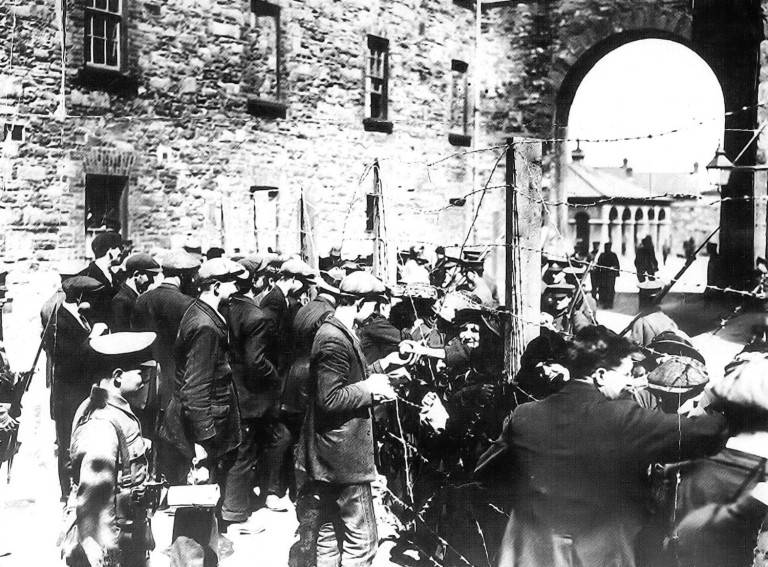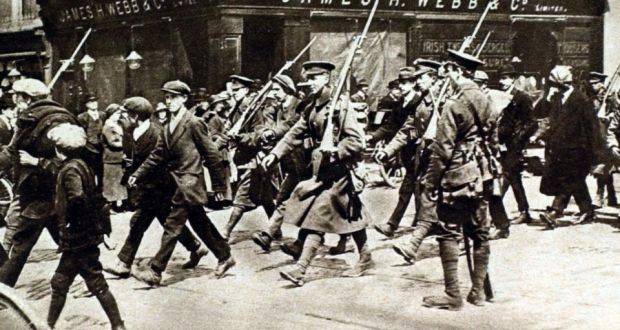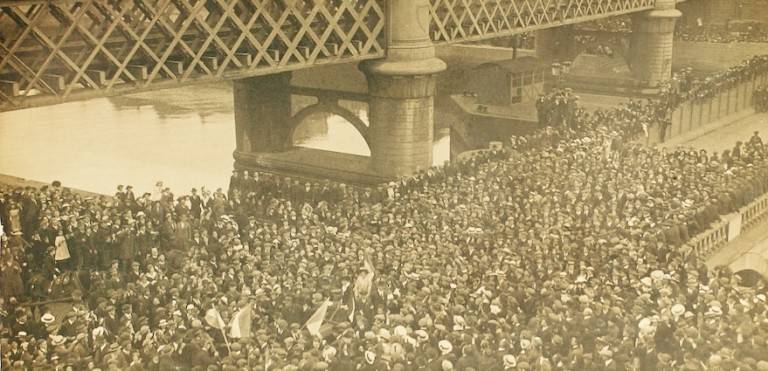Political Prisoners and Prison Life, 1915 to 1918, by Dr William Murphy

During the years 1915 to 1918 Irish political prisoners understood and represented their incarceration in a variety of ways. Imprisonment was, they thought, alternatively or in combination, an unjust imposition, an opportunity to bond, a school for sedition, and a metaphor for Ireland’s status. Others experienced it as tedium beyond measure, an adventure, debilitating in mind and body, a route to prominence, an occasion for resistance, or a waste of time to be avoided if possible. In parallel and linked to these individual and collective responses are patterns that can be discerned on the basis of changing cohorts of prisoners, different prison environments, and evolving strategies among the prisoners and their supporters.
Discussing Michael Collins’ brief imprisonment during the spring of 1918, the historian Peter Hart emphasized the importance of going to prison as a rite of passage for the revolutionary generation. Prison was, he wrote, ‘one of the vital transformative experiences that made clerks and farmers sons into new men: soldiers and martyrs’. This is evident from the beginning of the period, among the very few, perhaps as few as twenty, who were convicted during the year before the Rising. These men fell into four categories: known separatists (often members of the Irish Volunteers and IRB) who had attracted police attention because of organizational or propaganda work; less significant local activists often arrested as a direct consequence of anti-recruitment work; men who had no record of activism but who became embroiled in specific incidents of protest; and pacifists who actively opposed the war effort.
These pre-Rising prisoners were held individually or in small groups at Irish prisons (Belfast and Mountjoy), and for relatively short periods. They were not afforded a separate ‘political’ status and, in general, they did not mount organized protests in pursuit of this inside the prisons. Ernest Blythe, who was among them, suggested that they did not campaign for such a status, and the better treatment it would have entailed, because they did not understand that the English had ‘gone soft’ since the time of the Fenians.
Instead, as the Fenian prisoners had been, they were the subject of considerable propaganda and some political mobilization outside the prisons. The funeral of Jeremiah O’Donovan Rossa in August 1915, for example, encouraged the prisoners and propagandists to link the tyrannies of the past with oppressions of the present. In his famous funeral oration Patrick Pearse suggested that not only were the mourners in spiritual communion with O’Donovan Rossa and with ‘those who suffered with him in English prisons’ but with ‘our own dear comrades who suffer in English prisons to-day’. In the summer of 1915 entering a martyr elite and generating a propaganda of oppression was sufficient. An exception to this was the pacifist Francis Sheehy Skeffington. Rather than look to the Fenian model, he took his lead from the suffragette prisoners of the years before the war and brought militant protest – in the form of the hunger strike – into the prison, securing his release in the process.

According to Charles Townshend, during and in the immediate aftermath of the Easter Rising, the authorities arrested 3,430 men and 73 women. When commentators describe the Rising as a turning point, they usually point to the executions that followed, however, the rather indiscriminate sweeping up of most of those who were involved, along with many who were not, and the subsequent imprisonment or internment in Britain of more than half of these, was just as important. It affected not only the attitudes of hundreds of families and communities but nationalist public opinion in Ireland more generally. For more than a year these prisoners (internees and convicts) were living examples of the alleged high-handedness of the British response.
As noted in The Places of Detention, the convicted minority was detained in civil prisons (Dartmoor, Portland and Wormwood Scrubs) under strict convict conditions, although they were held apart from other prisoners. All were eventually transferred to Lewes in December 1916, where they experienced an improved regime. The early periods of exercise at Lewes were a series of re-unions and friendly introductions. Soon, the prisoners organised various activities and classes: Eoin MacNeill reported that ‘every morning at exercise I have a small class of two or three in Irish language or Irish history: peripatetics in earnest we are.’ Generally, Jack Plunkett remembered that the warders at Lewes ‘behaved merely like policemen and without the intense rigidity of the convict warders’, although Vincent Poole was punished when he pushed a little too far by singing ‘The Green Flag’. When stopped, Poole complained that he ‘might as well be in jail!’
Many of the convicts had been identified as having taken leadership roles or positions of prominence in the lead up to or during the Rising. When inspectors from the English Prison Commission visited them during their early weeks in jail they recorded that the Portland prisoners were ‘a distinctly prepossessing set of men’, while those at Dartmoor were of a striking ‘demeanour which was always respectful and courteous.’ They noted that the convicts were of firm political convictions and any expressions of regret for their rebellion were exceptional. They also warned that while they were quiet for the moment it would be mistaken to assume that this attitude would persist. This proved correct when the convicts became more assertive in the spring of 1917. Collected together under conditions where they could plan, these prisoners did not long remain satisfied with passive prison martyrdom but assertively challenged their gaolers in a manner that would become more typical in the years that followed.
Constance Markievicz, the only female convict, was held at Aylesbury prison. In her first letter from there, Markievicz told her sister Eva Gore Booth, ‘It’s queer and lonely here’. As the sole female rebel to be convicted the comforts of comradeship with other rebels were not open to her and, instead, she was held in the company of star class convicts. These were women who did not have a previous conviction or were considered not to be habitually criminal or corrupt. When the male rebel convicts were moved to Lewes, Markievicz’s comparatively under-privileged and isolated conditions were thrown into relief. Consequently, her rights to letters, visits, and writing facilities were extended. As various public bodies highlighted her case by electing her to honorary offices, she commented ‘I am glad that I am President of so many things! I should always advise societies to choose their presidents from among jail-birds, as presidents are always such a bore and so in the way on committees!’
After an initial period scattered across a range of detention centres, the 1916 internees were concentrated at three sites under conditions that approximated those of ‘prisoners of war’. The great majority of the men were held at Frongoch Camp (see The Places of Detention for detail). Reading Gaol became home to the remaining men: those who were considered ‘the leaders of the Sinn Feiners’. Their numbers varied between 25 and 40. The conflict that would emerge at Lewes and Frongoch did not, however, develop at Reading. Indeed, at the general release of internees in December 1916, the governor, Captain F.G. Morgan, reported that all the internees ‘expressed great satisfaction before leaving – at their treatment and I feel that myself and staff could safely walk through Ireland without being shot at.’
Five women were interned in Britain after the Rising: Helena Molony, Marie Perolz, Brieda Foley, Ellen Ryan, and Winifred Carney. They were selected from the twelve unconvicted women still in Mountjoy in early June 1916 and were transferred to Lewes female prison. Within a month, the Sankey Committee recommended that Perolz and Foley should be released and, at that point, the prison commission felt that they could no longer justify the cost of devoting Lewes to the use of three internees. Instead, they proposed their transfer to Aylesbury and this was ordered on 24 July. There the women were associated with ‘alien internees’ and afforded a very liberal regime.
Writing from Belfast Gaol in the summer of 1918, Kevin O’Higgins had no doubts about the effects that flowed from the jailing suspected separatist activists: ‘nothing,’ he insisted, ‘has helped so much the unity and solidarity of Sinn Féin as the association of large bodies of men from all parts of the country in the jails and in the internment camps in England in 1916. Besides all these men go out somewhat tougher, somewhat more determined, better equipped for the struggles that lie ahead. . . . in my opinion the more men there are in the country who have been through the mill in the jails the harder will England find it to govern this country hereafter. . . . Therefore out with the warrants, set on the G men, roll up the Black Maria, fill up the jails.’ There was, of course, a good deal of bravado in this statement. He was almost certainly writing as much for the censor’s benefit as for his friend outside. Yet, by then there is no doubt that the prisons had become places not only where those arrested were transformed into more effective revolutionaries but into sites of revolution.
Between the summer of 1917 and the emergence of guerilla warfare during 1919, hundreds of Irish Volunteers were held at Irish prisons. In most cases they had been convicted of participation in actions that Joost Augusteijn has characterized as forms of ‘public defiance’. These included public drilling or other forms of illegal assembly. During that period, they took this attitude of defiance into the prisons, ensuring that prison protest became, for a time at least, the most radical and effective form of revolutionary activity in Ireland. By inciting their own arrest, Irish Volunteers made British authority in Ireland visible and unpopular. Once in prison they challenged that authority, making it even more visible and more unpopular through protests such as hunger strikes, before undermining it and exposing it to ridicule by winning improved regimes or early release. One propagandist described prison protest at that time as ‘a branch of warfare not usually taught in drill-halls but none the less necessary to our soldiers of freedom’, while a veteran of the hunger strikes, riots and campaigns of concerted disobedience that characterized Irish prisons in 1917 and 1918 described the prisoners as ‘the Army of the Interior (of British prisons)’.
When the prisoners achieved an improved regime and association at designated prisons this could and did facilitate the planning of the next challenge to the authorities. It also enabled the emergence of a prison culture that was very similar to that at Frongoch Camp. In the autumn of 1918, for instance, one prisoner described Belfast prison as a ‘Grand Hotell (sic)’ and wrote ‘we can . . . do anything we like only go out.’ The prisoners congregated in cells – one nicknamed ‘Mulcahy’s Public House’ – to talk and hold classes. They had a manuscript newspaper and formed a literary society. They had sporting contests every day (handball, rounders or boxing) and concerts on Sunday nights and special occasions. They formed rival fraternal societies, including the ‘collare-and-tie’ men who wore nothing above the waist but a collar and tie, which proved an advantage to them during water-throwing contests.
A similar atmosphere and degree of freedom prevailed among the ‘German Plot’ internees held at English prisons between May 1918 and March 1919. This did not, however, undermine their potential as electoral assets at the general election of December 1918. Then, 34 of the German Plot internees were nominated by Sinn Féin and 28 won seats. In the run into the election one of those successful candidates, Seán Etchingham, wrote home: ‘I have a good chance if kept in prison while [the] election is in progress. The man in jail for Ireland’s cause is the man the people will rally round.’

This should not lull us into underestimating the rigours and privations of imprisonment that could affect both the physical and mental health of the prisoners. For example, following the general release of internees in December 1916, two – William Thomas Halpin and Edward Tierney – remained as inmates of Denbeigh Asylum for the insane in Wales. A Miss Richards and a Miss Robinson, who occasionally visited, reported that Tierney appeared to have been the more unwell. He did not appreciate the visits and seemed to be ashamed, constantly repeating that ‘he was a disgrace to his friends.’ After some lobbying by prisoner support groups, the men were moved to asylums nearer their families. In April, Tierney was transferred to Long Grove Asylum in Epsom, near London, and sometime later Halpin to Grangegorman Asylum, Dublin. Halpin died in Grangegorman later that year, while Tierney was finally released from Long Grove on 16 November 1917. Three other former internees of Frongoch – Christopher Brady, Jack O’Reilly, and Thomas Stokes – died during 1917 while William Partridge a 1916 convict died shortly after his release. It seems likely, thought it is impossible to be certain, that imprisonment contributed to these men’s deaths.
For good and ill then, imprisonment was vital to the personal experience of thousands of the men and women who made the Irish revolution while demanding significant levels of attention from, and posing intractable problems for, the state and its institutions. The prisons and camps were spaces where the state attempted to repress revolution but they were also spaces where revolutionary identities were shaped and sites where revolutionaries forcefully, sometimes successfully, challenged the state.
Dr William Murphy is a lecturer in the School of History and Geography, DCU. He is the author of Political Imprisonment and the Irish, 1912-1921 (2014).



